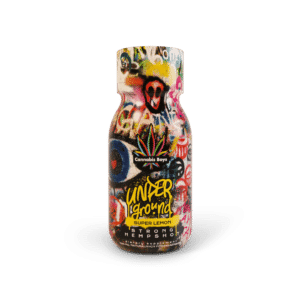CBD, like other hemp cannabinoids, acts on the human body through the endocannabinoid system - it activates it and through it regulates processes occurring in other body systems. Receptors of the endocannabinoid system are scattered throughout the body, and its purpose is to maintain balance (homeostasis) of the body.
What are cannabinoids?
Cannabinoids are a group of organic chemical compounds with special properties that allow them to regulate the functioning of cannabinoid receptors found in the body of humans and other mammals. Cannabinoid receptors are part of a network called the endocannabinoid system ( ESC ) .
Cannabinoids are divided into 3 groups depending on their origin:
- endocannabinoids: cannabinoids that are produced in the human body,
- phytocannabinoids: plant cannabinoids, e.g. hemp cannabinoids,
- synthetic cannabinoids: chemical compounds with a similar structure and action to endocannabinoids and phytocannabinoids, are synthesized by humans.
How do cannabinoids work on the human body?
The endocannabinoid system, although its role in the body is extremely important, was discovered recently. Only in 1988, an Israeli scientist, Professor Raphael Mechoulam, while examining hemp phytocannabinoids, noticed that in mammals there is a network of receptors to which they connect.
Professor Mechoulam has devoted his scientific career to exploring the secrets that cannabis still holds hidden from science. THC and CBD and map them, back in the 1960s Raphael Mechoulam died in March 2023 at the age of 92.
The role of the endocannabinoid system in the body
The Israeli scientist's research team discovered that the ECS system plays a key role in maintaining homeostasis in the body. It regulates, among others: the functioning of the immune, secretory and nervous systems. When the endocannabinoid system is functioning properly, it is able to influence many other processes in the body. For example, regulate the strength and adequacy of the immune system's response and, depending on the situation, increase resistance to pathogens or alleviate the symptoms of autoimmune diseases.
Therefore, by influencing the ECS system by taking CBD or other hemp cannabinoids , we are able to influence other processes, e.g. inhibit the development of diseases .
Structure of the endocannabinoid system:
- Cannabinoid receptors:
The cannabinoid receptors CB1 and CB2 are the best studied and described. The former are most abundant in the brain, the latter in the immune and nervous systems.
- Endocannabinoids:
Cannabinoids produced by the human body are responsible for activating or inhibiting CB1 and CB2 receptors. The most important endocannabinoids are AEA and 2AG.
- Enzymes:
Metabolic enzymes that are responsible for the synthesis and degradation of cannabinoids.
Hemp phytocannabinoids
Phytocannabinoids, or plant cannabinoids, are fat-soluble chemical compounds produced by plants, especially those of the Cannabis . In hemp, most cannabinoids are found in female flowers, in characteristic hairs that secrete resin.
Currently, researchers have recognized approximately 100 hemp phytocannabinoids. The best known cannabinoids are:
- 9-delta-tetrahydrocannabinol (THC),
- cannabidiol (CBD),
- cannabigerol (CBG),
- cannabichromene (CBC),
- cannabinol (CBN),
- cannabidiolic acid (CBDA),
- tetrahydrocannabivarin (THCV),
- tertahydrocannabinolic acid (THCA).
What diseases can CBD and other hemp cannabinoids be used for?
Above, we discussed how CBD works in the body via the endocannabinoid system. Understanding that cannabinoids regulate the functioning of the ECS, which in turn regulates other processes in the body, it is easy to guess that hemp can be a valuable support in the treatment of many different diseases.
Currently, drugs based on hemp cannabinoids are an approved form of therapy in various places around the world for the following diseases:
- severe childhood and adult epilepsy (Lennox-Gastaut syndrome),
- other forms of epilepsy,
- side effects of chemotherapy (including nausea, vomiting, lack of appetite , body emaciation, weight loss),
- eating disorders, anorexia,
- neuropathic pain,
- other types of pain
- spasticity,
- inflammatory bowel diseases,
- mood disorders,
- memory disorders,
- arthritis,
- PTSD.
Scientific research is still ongoing on the mechanism of action of hemp cannabinoids in various processes occurring in the body, e.g. inflammation, decreased immunity and various diseases, e.g. endometriosis, Alzheimer's disease, depression, alcohol addiction, skin diseases and autoimmune diseases. Year by year, knowledge about hemp cannabinoids is increasing, and research is increasingly entering the clinical phase, allowing the observation of the effects of hemp-based drugs on patients and determining the most effective dosage of cannabinoids and the method of their administration.









[…] Hemp cannabinoids, including CBD, have a number of properties that can support the therapy of people after a traumatic experience. These include: […]
[…] struggling with skin problems such as atopic dermatitis or eczema, but not only that. Hemp cosmetics also have a moisturizing and soothing effect, which is why they are also perfect for everyday [...]
[...] the content of over 100 active cannabinoids - compounds that affect the cannabinoid system in the human body, allows you to alleviate the symptoms of many diseases and pain of various origins, by […]
[…] in immune cells. The receptors are activated by two endocannabinoids produced by the human body: anandamide and […]
[…] the first phase of an ongoing study using CBD and other cannabinoids published in 2022 showed that dried hemp can improve symptoms within 4 weeks […]
[…] plays a special role. ECS receptors, called CB1 and CB2, are scattered throughout the human body, including the skin - thanks to this, both natural endocannabinoids produced [...]
[...] red eyes after taking cannabis is the use of varieties of the plant that do not contain THC. Other hemp cannabinoids, including CBD, do not cause eye redness. Even though CBD can also lower blood pressure […]